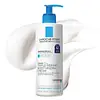What's inside
What's inside
 Key Ingredients
Key Ingredients

 Benefits
Benefits

 Concerns
Concerns

 Ingredients Side-by-side
Ingredients Side-by-side

Water
Skin ConditioningGlycerin
HumectantPetrolatum
EmollientCaprylic/Capric Triglyceride
MaskingHydrogenated Vegetable Oil
EmollientSucrose Distearate
EmollientDextrin
AbsorbentHelianthus Annuus Seed Oil Unsaponifiables
EmollientPrunus Domestica Seed Extract
Emollient1,2-Hexanediol
Skin ConditioningCandelilla Cera
EmollientSqualane
EmollientSucrose Stearate
EmollientGlyceryl Caprylate
EmollientXanthan Gum
EmulsifyingGlucose
HumectantSorbitol
HumectantPersea Gratissima Fruit Extract
EmollientCeramide NP
Skin ConditioningPhytosphingosine
Skin ConditioningWater, Glycerin, Petrolatum, Caprylic/Capric Triglyceride, Hydrogenated Vegetable Oil, Sucrose Distearate, Dextrin, Helianthus Annuus Seed Oil Unsaponifiables, Prunus Domestica Seed Extract, 1,2-Hexanediol, Candelilla Cera, Squalane, Sucrose Stearate, Glyceryl Caprylate, Xanthan Gum, Glucose, Sorbitol, Persea Gratissima Fruit Extract, Ceramide NP, Phytosphingosine
Water
Skin ConditioningButyrospermum Parkii Butter
Skin ConditioningGlycerin
HumectantDimethicone
EmollientNiacinamide
SmoothingCetearyl Alcohol
EmollientBrassica Campestris Seed Oil
Skin ConditioningGlyceryl Stearate
EmollientAmmonium Polyacryloyldimethyl Taurate
Emulsion StabilisingPEG-100 Stearate
Propanediol
SolventOphiopogon Japonicus Root Extract
Skin ConditioningCeramide NP
Skin ConditioningSorbitan Tristearate
EmulsifyingDimethiconol
EmollientPEG-20 Methyl Glucose Sesquistearate
EmulsifyingSodium Chloride
MaskingMannose
HumectantCoco-Betaine
CleansingDisodium EDTA
Capryloyl Glycine
CleansingCaprylyl Glycol
EmollientVitreoscilla Ferment
Skin ConditioningCitric Acid
BufferingMaltodextrin
AbsorbentXanthan Gum
EmulsifyingTocopherol
AntioxidantPentaerythrityl Tetra-Di-T-Butyl Hydroxyhydrocinnamate
AntioxidantWater, Butyrospermum Parkii Butter, Glycerin, Dimethicone, Niacinamide, Cetearyl Alcohol, Brassica Campestris Seed Oil, Glyceryl Stearate, Ammonium Polyacryloyldimethyl Taurate, PEG-100 Stearate, Propanediol, Ophiopogon Japonicus Root Extract, Ceramide NP, Sorbitan Tristearate, Dimethiconol, PEG-20 Methyl Glucose Sesquistearate, Sodium Chloride, Mannose, Coco-Betaine, Disodium EDTA, Capryloyl Glycine, Caprylyl Glycol, Vitreoscilla Ferment, Citric Acid, Maltodextrin, Xanthan Gum, Tocopherol, Pentaerythrityl Tetra-Di-T-Butyl Hydroxyhydrocinnamate
 Reviews
Reviews

Ingredients Explained
These ingredients are found in both products.
Ingredients higher up in an ingredient list are typically present in a larger amount.
Ceramide NP is a type of ceramide and formally known as ceramide 3.
Ceramides are intercellular lipids naturally found in our skin that bonds dead skin cells together to create a barrier. They are known for their ability to hold water and thus are a great ingredient for dry skin.
Ceramides are an important building block for our skin barrier. A stronger barrier helps the skin look more firm and hydrated. By bolstering the skin ceramides act as a barrier against irritating ingredients. This can help with inflammation as well.
If you would like to eat ceramides, sweet potatoes contain a small amount.
Read more about other common types of ceramides here:
Ceramide AP
Ceramide EOP
Glycerin is already naturally found in your skin. It helps moisturize and protect your skin.
A study from 2016 found glycerin to be more effective as a humectant than AHAs and hyaluronic acid.
As a humectant, it helps the skin stay hydrated by pulling moisture to your skin. The low molecular weight of glycerin allows it to pull moisture into the deeper layers of your skin.
Hydrated skin improves your skin barrier; Your skin barrier helps protect against irritants and bacteria.
Glycerin has also been found to have antimicrobial and antiviral properties. Due to these properties, glycerin is often used in wound and burn treatments.
In cosmetics, glycerin is usually derived from plants such as soybean or palm. However, it can also be sourced from animals, such as tallow or animal fat.
This ingredient is organic, colorless, odorless, and non-toxic.
Glycerin is the name for this ingredient in American English. British English uses Glycerol/Glycerine.
Learn more about GlycerinWater. It's the most common cosmetic ingredient of all. You'll usually see it at the top of ingredient lists, meaning that it makes up the largest part of the product.
So why is it so popular? Water most often acts as a solvent - this means that it helps dissolve other ingredients into the formulation.
You'll also recognize water as that liquid we all need to stay alive. If you see this, drink a glass of water. Stay hydrated!
Learn more about WaterXanthan gum is used as a stabilizer and thickener within cosmetic products. It helps give products a sticky, thick feeling - preventing them from being too runny.
On the technical side of things, xanthan gum is a polysaccharide - a combination consisting of multiple sugar molecules bonded together.
Xanthan gum is a pretty common and great ingredient. It is a natural, non-toxic, non-irritating ingredient that is also commonly used in food products.
Learn more about Xanthan Gum